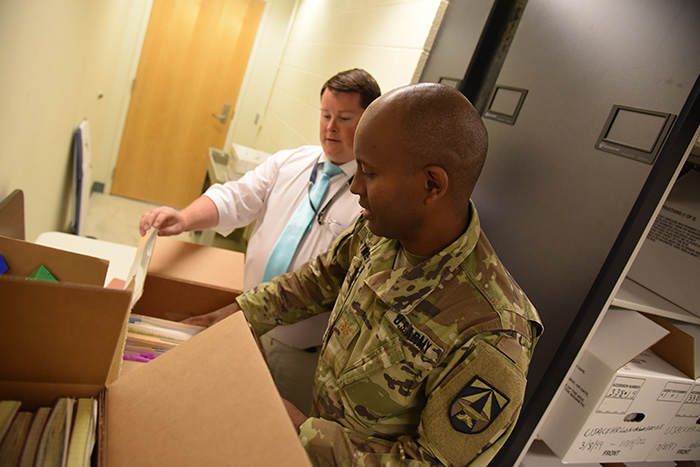USACEHR Legacy, Impact Secure as Move to WRAIR Starts in Earnest

When the sun first rises over the eastern edge of Fort Detrick each morning, the light always falls the same way; first hitting the guard booths at Veteran's Gate before enveloping Blue and Gray Field and then, eventually, everything else. But even on the brightest of days, it always takes a little while longer for the sun to find the U.S. Army Center for Environmental Health Research, the tiny program tucked into an unassuming red brick building near the center of post.
The irony is not lost on the USACEHR staff.
"It's one of those things," says David Trader, a research biologist and executive officer who's been at USACEHR since 2002, "we do a lot of great work and not a lot of people know about us."
In most other situations they'd be hard to miss. They are, after all, an organization that combines high-profile partnerships with entities like Harvard University, NASA and SpaceX along with an over-arching mission focused on the protection of Soldiers from mission-related environmental health threats. And yet just as the program starts to gain greater national attention for their work, they're set to move to a different –and far larger– stage. On July 15, USACEHR will be deactivated and then absorbed by the Walter Reed Army Institute of Research as part of an Army-wide reorganization effort.
As a result, many of the remaining staffers at Fort Detrick now view the next several weeks as part of a long, slow and bittersweet goodbye.
"We've always been a small but mighty program," says CPT Matthew Kobe, a two-year USACEHR veteran who works on finding biomarkers that will help diagnose injuries in Soldiers more quickly. "So while the move is sad from a team and friendship standpoint, it has to happen to fulfill the mission of the Army."
As is common in so many of the research programs housed at Fort Detrick, the people behind the acronym are just as integral to the final product as the mission itself. Existing in one form or another since its birth in 1972 as the U.S. Army Medical Bioengineering Research and Development Laboratory, USACEHR has evolved to its current state by consistently supplying cutting-edge research with a bent towards the development of knowledge products; and has rested over the course of the recent past as a subordinate command of the U.S. Army Medical Research Institute of Chemical Defense. Notable efforts from USACEHR include the development of a fish biomonitoring system to determine toxicity levels in water bodies, and launching mice into orbit to study the impact of microgravity on bone density. For staffers, the constant among those varied projects was –and still is– a commitment to the twin tenets of collaboration and communication.
"The best part of working in such a small office was always the talking and sharing," says USACEHR Laboratory Chief Dr. Aarti Gautam. "Instead of emailing we would just walk into somebody's office, and we'd end up getting more information that way."
Says Kobe in agreement, "We really are a tight-knit community."
Both Kobe and Gautam represent the twin pathways now facing the remaining personnel at USACEHR; a number that has dropped precipitously from a one-time high of 60 people to, now, a little more than 20 total staffers. Kobe will stay at Fort Detrick and transfer to another program on the installation, while Gautam will be part of the large contingent slated to follow all active and funded current research projects to WRAIR's campus in Silver Spring, Maryland.
"I have full confidence in the USACEHR and WRAIR teams who are working diligently to ensure a seamless transition and integration of those projects aligned with WRAIR's research portfolio," said WRAIR Commander Col. Deydre S. Teyhen in a statement regarding her excitement over the move. "We embrace these new programs and the experienced staff who will expand our ability to develop new products to protect and enhance the nation's top weapon's system - the U.S. Soldier."
Yet that excitement is tempered –for now, at least– with a hint of melancholy from the folks at USACEHR.
"It's just a sad feeling leaving the people," says Gautam. "Friendship-wise this has been a wonderful place to work."
As for Trader, the civilian employee with 15 years of experience at USACEHR, he's been tasked with, in so many words, turning off the lights. He'll help transition the program to WRAIR and then, eventually, head down there himself, memories in tow.
"We always punched above our weight when it came to impact," he says of USACEHR. "So much of the work we did was foundational, in that a lot of the research we did was then used by other programs."
And in the end, perhaps that's the greatest takeaway for the outgoing crew at USACEHR: that nearly a half-century worth of effort is still there, still funded, and just as important as it's ever been, even if the mailing address is changed slightly. After all, when your achievements are as plain as day, perhaps it really doesn't matter where you work … or even whether the sunlight finds you or not.
Says Trader, "Going from a small lab to a big lab, it's going to be bittersweet, but we're Army scientists at the core, and if the Army needs it, then we're going to do what the Army needs."














